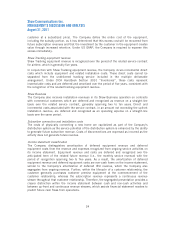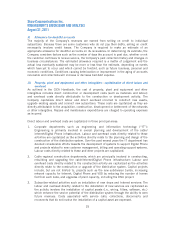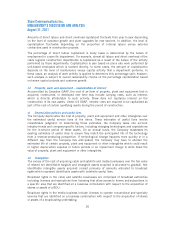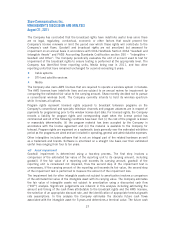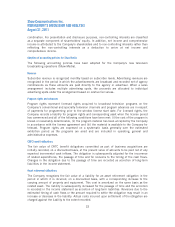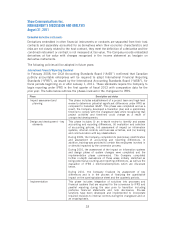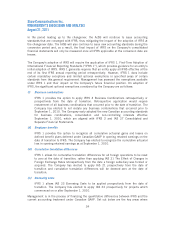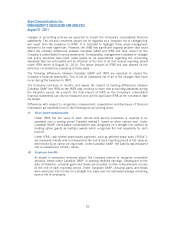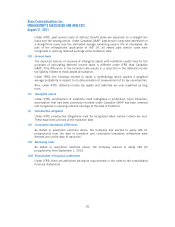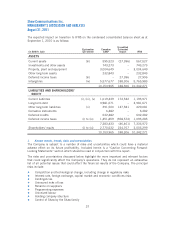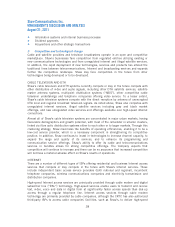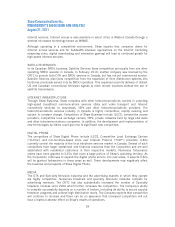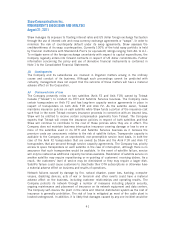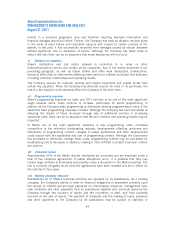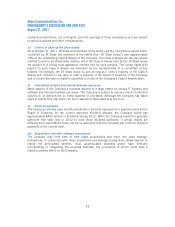Shaw 2011 Annual Report Download - page 38
Download and view the complete annual report
Please find page 38 of the 2011 Shaw annual report below. You can navigate through the pages in the report by either clicking on the pages listed below, or by using the keyword search tool below to find specific information within the annual report.Shaw Communications Inc.
MANAGEMENT’S DISCUSSION AND ANALYSIS
August 31, 2011
In the period leading up to the changeover, the AcSB will continue to issue accounting
standards that are converged with IFRS, thus mitigating the impact of the adoption of IFRS at
the changeover date. The IASB will also continue to issue new accounting standards during the
conversion period and, as a result, the final impact of IFRS on the Company’s consolidated
financial statements will only be measured once all IFRS applicable at the conversion date are
known.
The Company’s adoption of IFRS will require the application of IFRS 1, First-Time Adoption of
International Financial Reporting Standards (“IFRS 1”), which provides guidance for an entity’s
initial adoption of IFRS. IFRS 1 generally requires that an entity apply all IFRS effective at the
end of its first IFRS annual reporting period retrospectively. However, IFRS 1 does include
certain mandatory exceptions and limited optional exemptions in specified areas of certain
standards from this general requirement. Management has assessed the exemptions available
under IFRS 1 and their impact on the Company’s future financial position. On adoption of
IFRS, the significant optional exemptions considered by the Company are as follows:
(i) Business combinations
IFRS 1 provides the option to apply IFRS 3 Business Combinations retrospectively or
prospectively from the date of transition. Retrospective application would require
restatement of all business combinations that occurred prior to the date of transition. The
Company has elected to not restate any business combinations that occurred prior to
September 1, 2010. The Company early adopted the new Canadian accounting standards
for business combinations, consolidation and non-controlling interests effective
September 1, 2010, which are aligned with IFRS 3 and IAS 27 Consolidated and
Separate Financial Statements.
(ii) Employee benefits
IFRS 1 provides the option to recognize all cumulative actuarial gains and losses on
defined benefit plans deferred under Canadian GAAP in opening retained earnings on the
date of transition to IFRS. The Company has elected to recognize the cumulative actuarial
loss in opening retained earnings as at September 1, 2010.
(iii) Cumulative translation differences
IFRS 1 allows for cumulative translation differences for all foreign operations to be reset
to zero at the date of transition, rather than applying IAS 21 The Effect of Changes in
Foreign Exchange Rates retrospectively from the date a foreign subsidiary was formed or
acquired. The Company has elected to apply IAS 21 prospectively from the date of
transition and cumulative translation differences will be deemed zero at the date of
transition.
(iv) Borrowing costs
IFRS 1 allows IAS 23 Borrowing Costs to be applied prospectively from the date of
transition. The Company has elected to apply IAS 23 prospectively for projects which
commenced on or after September 1, 2010.
Management is in the process of finalizing the quantitative differences between IFRS and the
current accounting treatment under Canadian GAAP. Set out below are the key areas where
34


